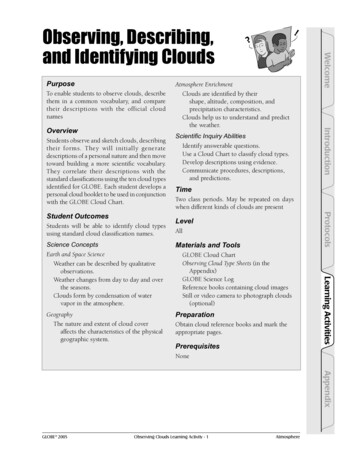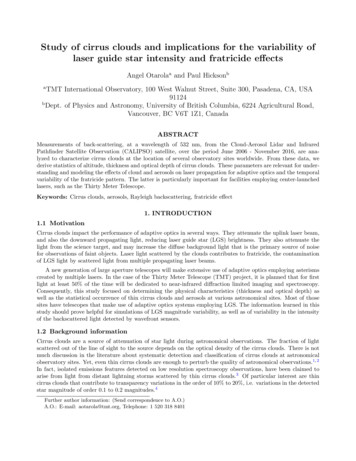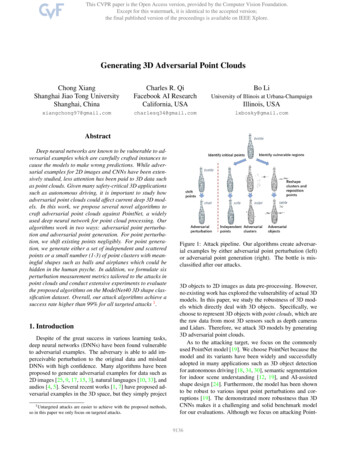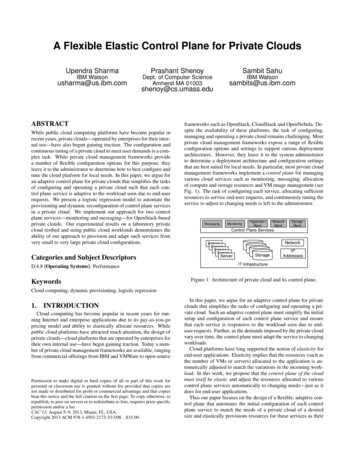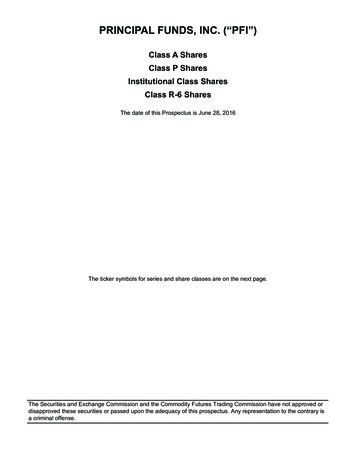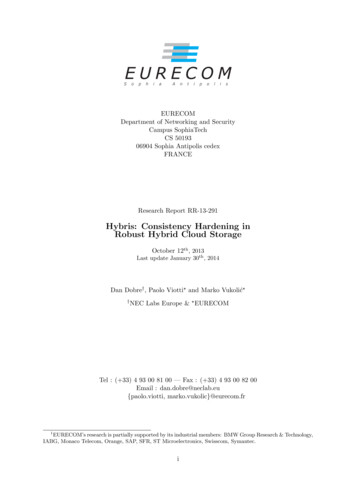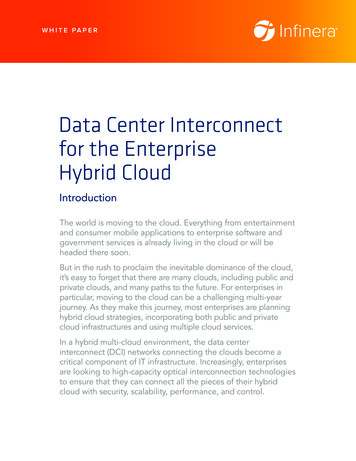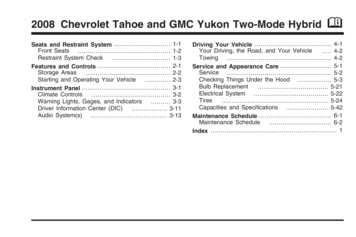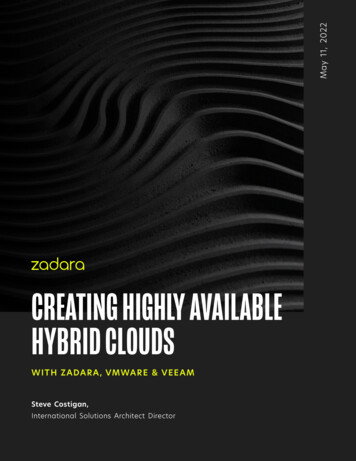
Transcription
May 11, 2022CREATING HIGHLY AVAILABLEHYBRID CLOUDSW IT H Z ADA RA , VMWA R E & V EEA MSteve Costigan,International Solutions Architect DirectorCreating Highly Available Hybrid Clouds with Zadara, VMware, and Veeam 1
TABLE OF CONTENTSINT ROD UC T I O N . . . . . . . . . . . . . . . . . . . . . . . . . . . . . . . . . . . . . . 4ENV I RONMENT. . . . . . . . . . . . . . . . . . . . . . . . . . . . . . . . . . . . . . . 4ZADA RA . . . . . . . . . . . . . . . . . . . . . . . . . . . . . . . . . . . . . . . . . 4VE EA M AVA I L A B I L I T Y S U I T E . . . . . . . . . . . . . 4VMWA R E CLOU D O N AWS . . . . . . . . . . . . . . . . . . . . . . . . 5TH E CH A L L ENG E . . . . . . . . . . . . . . . . . . . . . . . . . . . . . . . . . . . . 5IM PL EMENTI NG H YB R I D C LO U D STO RAG E . . . 5DEPLOYMENT O P T I O N S . . . . . . . . . . . . . . . . . . . . . . . . . . 6DEPLOYMENT WA L K T HRO U GH P L A N N ING . . . 9CR EATI NG VMWA R E C LO U D O N AWS S OFTWARE DE FI NE D DATA C E NTE R (SDDC ). 10ZADA RA STORAG E S E RV I C E S DE P LOYM E NT. . 14VP SA NAS I NT EGRAT I O N S . . . . . . . . . . . . . . . . . . . . . . 17AD D I NG V EEA M TO O U R H YB R I D C LO U D. . 18VE EA M BAC K U P R E P O S I TO RY. . . . . . . . . . . . . . . . . . 20VE EA M BAC K U P J O B C R E AT I O N . . . . . . . . . . . . . . 23VMWA R E G UEST I S C S I VM S N A P S HOT P ROTEC TI ON . . . . 29ZADA RA VS S H W P ROV I DE R DE P LOYM E NT. . 29VE EA M / Z A DA RA VS S H W P ROV I DE R I N TEG RATI ON. . 37SUMMA RY. . . . . . . . . . . . . . . . . . . . . . . . . . . . . . . . . . . . . . . . . 39Creating Highly Available Hybrid Clouds with Zadara, VMware, and Veeam 2
REVISION HISTORYV ERSIONDAT EDE S CR IPT I O N1.022 Aug 2019Initial ReleaseCreating Highly Available Hybrid Clouds with Zadara, VMware, and Veeam 3
INTRODUCTIONThis guide is intended to provide an insight into the capabilities of utilising Veeam and Zadara to providea comprehensive suite of data protection capabilities in AWS, VMware Cloud on AWS, VMware ESXi in anydeployment, Private Hybrid or Public Cloud.ENVIRONMENT Single Node VMware Software Defined Data Center in AWS using NSX-T Veeam Backup and Replication 9.5 Update 4 on SDDC with Zadara via NSX-T VMware SDDC Version 1.5 Zadara VPSA All Flash Array, Hybrid Array and Object Storage Zadara VSS Hardware ProviderZADARA Zadara is agile, secure enterprise data storage built for hybrid IT. We help organizations eliminate the cost andcomplexity traditionally associated with data storage, by providing enterprise data storage solutions as a fully-managedservice, with a 100%-uptime guarantee and OpEx consumption-based pricing. Zadara uses industry-standard hardwareand patented Zadara software to deliver the power of enterprise-class data storage and management — with theconvenience of the cloud. Any data type. Any protocol. Any location. Zadara is available via public clouds, managedservice providers, data centers, colocation partners, and on premises in customers' data centers.Zadara’s storage services deliver high performance all-flash, flash cache-accelerated hard disk, and object storageservices with unique multi-tenant resource isolation. This ability to deliver multiple storage tiers with consistentand predictable performance, even in shared environments, is the perfect complement to Veeam Availability Suiteand VMware Clouds.VEEAM AVAILABILITY SUITE Veeam Availability Suite delivers Availability for ALL workloads — virtual, physical and cloud — from a singlemanagement console. Veeam helps organizations meet today’s service-level and data center Availability objectivesfor the growing enterprise. Veeam Availability Suite is the premier solution providing the superior data protectioncapabilities of Veeam Backup & Replication paired with the advanced monitoring and reporting of Veeam ONE for holistic coverage of all workloads.Creating Highly Available Hybrid Clouds with Zadara, VMware, and Veeam 4
VMWARE CLOUD ON AWSVMware Cloud on AWS is an integrated cloud offering jointly developed by AWS and VMware delivering a highlyscalable, secure and innovative service that allows organizations to seamlessly migrate and extend their on-premisesVMware vSphere-based environments to the AWS Cloud running on next-generation Amazon Elastic ComputeCloud (Amazon EC2) bare metal infrastructure. VMware Cloud on AWS is ideal for enterprise IT infrastructureand operations organizations looking to migrate their on-premises vSphere-based workloads to the publiccloud, consolidate and extend their data center capacities, and optimize, simplify and modernize theirdisaster recovery solutions.THE CHALLENGEThe objective is to create a complete, production-ready hybrid cloud environment that offers high-performance,a familiar and proven operating environment, and complete data backup, recovery, and replication capabilities.Achieving these ambitious goals with legacy solutions would generally require extensive custom integration ofmultiple complex packages. However, by leveraging Zadara Enterprise Storage-As-A-Service, VMware Cloud,and Veeam Availability Suite, our goals can be achieved by a knowledgeable practitioner in just a few hours.IMPLEMENTING HYBRID CLOUD STORAGEFor this exercise, we will simultaneously present both iSCSI block and NAS (NFS/SMB) to both the VMware CloudVirtual Private Cloud (VPC) and an independent VPC comprised of EC2 guests. Backups targeted at object storagecan be directed to either Zadara Object Storage or S3.Creating Highly Available Hybrid Clouds with Zadara, VMware, and Veeam 5
DEPLOYMENT OPTIONSFor testing purposes a single node SDDC VMC was defined in AWS London. Setup consists of a single node with10TB of vSAN SSD storage, split into: A vSAN Datastore for vCenter, NSX, and other VMware-provided management VMs A Workload Datastore for hosting user VM’sFirst the environment must be defined in the intended location, in this case AWS London. There are several stepsrequired for this, including defining the management network and the AWS VPC to attach to. You also need accessto your AWS environment with permissions to launch a Cloud Formation script, so planning ahead is essential toa smooth deployment.Once deployment has been completed, which usually takes 120 minutes from submitting the request, youcan manage the security setup for the VMC SDDC. This includes allowing access to the vCenter environmentvia the public IP defined to it, enabling access from the VPC EC2 instances, and enabling access via AWS DirectConnect, if applicable.Once this is complete you can test accessibility to your VMC vCenter. At this point you may want to enable DirectConnect to your VMware Cloud management network, this is where the up-front planning will come in as it isimperative to avoid accidentally overlapping address ranges. If accessing the VMware Cloud management networkvia Direct Connect, configure the interfaces to be offered to the VMware-specific account supplied as part of theVMware Cloud install.Creating Highly Available Hybrid Clouds with Zadara, VMware, and Veeam 6
This is where it gets interesting. In the current VMware Cloud on AWS, guest VMs are stored on the SSD pool (10 TBraw per ESXi host, approximately 15 TB usable for a 3-node cluster). This storage provides very good performance,but has two key shortcomings: Only one vSAN environment is supported. Therefore all backup storage traffic will compete directly withproduction workloads. This is not good. There is no option to provide multiple performance tiers to align application requirements, performance,and cost.If we don’t want to have backup traffic impacting production and/or we want the ability to provide applications withstorage capacity that aligns with business requirements, what are the options?Prior to SDDC v1.5, we were limited by NSX-V functionality to backup applications that could track and backupVMware environments. However, these solutions tend to require complex configuration, particularly whenimplementing the best practice of automatic offsite backup creation is a design point.One possible approach would be to deploy a Linux VM, connected to EBS, and running SSH and Perl to expose anNFS export. However this is complex and also creates a single point of failure (the NFS export). Furthermore, goingthis route will mean that everything is going to be located in the same Availability Zone (AZ) and Data Center, whichis a suboptimal backup strategy. Therefore, S3 must also be utilised for protection to meet the requirements, addingyet another layer of complexity. You could address availability concerns by keeping another copy in another AZ, butnow you are adding complexity; 2 Linux nodes, 2 sets of EBS. And this is going to need to be SSD as the magneticoption has a 1TB limit. The backup costs are rising precipitously and complexity is increasing geometrically, greatlyincreasing the risk of failure.Fortunately, Veeam is a certified VMware Cloud backup solution and listed in the VMware Cloud Marketplace, sowe can use it in the VMware Cloud and/or the EC2 VPC, but we still need to connect Veeam to appropriate storage.The simple solution is to present Zadara iSCSI block or SMB NAS volumes to the EC2 instance. This way, even initialbackups are automatically stored outside of the AWS data center housing the VMware Cloud and EC2 VPCs.With NSX-T, we now have an even simpler option; we can now use Zadara’s enterprise storage-as-a-service toprovide an iSCSI Block volume to a Veeam Backup Server within VMware Cloud environment. This enables a backuprepository which has high availability built in, enhancing the availability and integrity of backups.To further enhance data availability, the backups created on Zadara storage can be replicated to any other Zadaravirtual private array or, alternatively via Zadara Backup to Object Storage, to any S3 / Swift compatible Objectstorage array including Zadara’s object storage service or Amazon S3 itself.In addition to the object storage service, Zadara storage also offers NAS with NFS and SMB services. Either or bothof these services can be used for primary data as well as backup. For this project, we will implement the ActiveDirectory-integrated SMB NAS service. Physics and locking permitting, our service will be capable of serving the samedata to applications and users within our VMware Cloud, the EC2 VPC and on-premises.Creating Highly Available Hybrid Clouds with Zadara, VMware, and Veeam 7
Consider the possibilities! VDI running in AWS, accessing servers in VMware Cloud, with data persisted on highlyavailable shared storage, offering client-based recovery using the standard “Previous Versions” capability built intoevery Windows client. And all the shared data can be automatically protected with Zadara’s optional integratedMcAfee antivirus.Veeam and Zadara integrated into a hybrid cloud solution, data automatically backed up to S3, set it forget it,but know it will be where you need it when you need it. Need to support Windows and Linux? No problem.Support NFS clients with the same replication capabilities as SMB. Support access to the same files with NFSand SMB. All wrapped up with an integrated backup solution using Windows and Linux Agents from Veeam.The last piece of our project will be to support Windows Failover Server Clustering (WFSC). For deployments limitedto vSAN, there is good news and bad news. The good news is that vSAN 6.7 introduced support for failover clustersvia the iSCSI target Service, and the latest VMware Cloud on AWS SDDC enables a shared VMDK capability. The badnews is that the current offerings do not provide snapshots, let alone a Volume Shadow Copy Service (VSS) providerto ensure application consistent snapshots.Implementing hybrid cloud storage from Zadara, addresses these limitations and provides additional availabilityoptions like remote mirroring and multi-zone HA, while enabling all of the benefits of VMware Cloud on AWS andproviding a consistent service, independent of how (and where) your Zadara storage is physically deployed.Creating Highly Available Hybrid Clouds with Zadara, VMware, and Veeam 8
DEPLOYMENT WALK THROUGH PLANNINGBy default the SDDC will utilise a 10.0.0.0/20 network for management functions, ensure that this is not in conflictwith your environment or your VPC environment. Check out the Zadara Setup Guide http://guides.zadarastorage.com/this may be updated depending upon Zadara deployment version such as this for the 18.11 release tting-started.html. Zadara virtual private arrays will typically beon a 172.x.x.x network, depending upon the region. However Zadara supports custom networks and thiscan be set to a customer specific range if required.Below is a typical top-level Zadara-to-SDDC-to-VPC configuration.Note: SDDC VM's require NSX-T to communicate via DXconnections, VM Compute cannot talk to DX routes via VPC,but can talk to EC instances via ENI Interfaces.Creating Highly Available Hybrid Clouds with Zadara, VMware, and Veeam 9
CREATING VMWARE CLOUD ON AWS SOFTWARE DEFINED DATA CENTER (SDDC) To create an organization account and request a new SDDC, head over to https://cloud.vmware.com/vmc-aws Create your SDDC via the Creation Wizard. Link to your AWS Account. Note that you must have Cloud formation rights in your AWS Account.Creating Highly Available Hybrid Clouds with Zadara, VMware, and Veeam 10
Identify the VPC and subnet for your environment that you want to connect to your VMC SDDC. Once Connection has been successfully established, you will see the following success message: Once All Networking information has been submitted and the request to createhas been completed you will seethe following screens:Creating Highly Available Hybrid Clouds with Zadara, VMware, and Veeam 11
Upon completion you will see the following:Creating Highly Available Hybrid Clouds with Zadara, VMware, and Veeam 12
When logging into the VMware in AWS console, you will see the following for each SDDC that you have defined: View Details displays a summary and allows you to set the networking firewall rules. Networking and Security displays an overview of connections and how they are related to variousnetwork environments.Creating Highly Available Hybrid Clouds with Zadara, VMware, and Veeam 13
Note the Public IP is the Public IP of the vCenter mapped by VMware Cloud on AWS for management. Themanagement network is defined previously, during SDDC setup. In the Security Tab you need to define access rulesfor management and access to vCenter. By default, everything is denied. Create new objects for specific IP’s toenable access and then grant access to vCenter, for instance:At this point you can begin setting up the SDDC environment and begin the processof requesting the Zadara virtual private array that we are going to connect.Before requesting the Zadara storage service, we need to get the AWS Account IDfor the SDDC. Click on Direct Connect in the SDDC Networking and Security tab.ZADARA STORAGE SERVICES DEPLOYMENTFor the next step, head over to https://manage.zadarastorage.com and request a new AWS VPSA to be created inthe AWS region containing the just-deployed SDDC. Alternatively, you can sign in to your AWS Account and make therequest via B07K4WPL9X?qid 1564583550014&sr 0-1 &ref srh res product title.Complete the details in the signup form or once complete send an email to support@zadarastorage.com. Documentthe virtual array name, your account name, and the AWS Account ID that you want the Direct Connect VirtualInterfaces (DXVI) offered to, as well as the BGP ASN assigned to your environment.Note: The AWS VPC Account ID and the AWS VMware Cloud Account ID’s are different. You need to supply theVMware-supplied account details.Once they have been offered, head back into the SDDC Direct Connect pane and accept the 2 virtual interfaces.After a few minutes you should see something similar to this, showing the learned and advertised routes from theSDDC and the Zadara sides:Creating Highly Available Hybrid Clouds with Zadara, VMware, and Veeam 14
You will also need to configure rules to allow access between the VM Networks and the VPC’s, the VM Network andthe Direct Connect allowing specific services as required to the VPSA Arrays.Note: At this point you may need to ensure that traffic can flow via the VPC ENI to the SDDC. Ensure that the rulesapplied allow two way communication between the EC2 instances and any configured VM’s in the compute gateway.If your VPC also needs iSCSI, NFS, SMB storage from a Zadara VPSA Array, then additional DXVIs will need to beprovisioned – speak to your Zadara account manager about this.At this point you can either continue managing and provisioning the Zadara storage, or you can schedule an“onboarding” session with Zadara support to help get you up on running.If we now log in to our VPSA you should see a Dashboard similar to this (this example is using a Zadara all-flash array).Creating Highly Available Hybrid Clouds with Zadara, VMware, and Veeam 15
Or this if using a Zadara hybrid storage array:The Servers Tab allows us to register new Clients and setup access to volumes. Here you can see that we arepresenting NFS volumes to ESX Servers as a datastore. We also have some Windows clients defined in both the AWSVPC and the ESX Compute Network via NSX-T.Servers can be registered manually or automatically via a setup script from the virtual private array.Below, we can see the range of volumes presented from our virtual private array to both EC2 instances, ESXi Hosts,and VM Guests, all from a single Zadara VPSA. Actual deployment and capabilities may vary by region. Check withyour Zadara team for capabilities in each region.Creating Highly Available Hybrid Clouds with Zadara, VMware, and Veeam 16
Here you can see the two Zadara-presented NFS Datastores attached to the SDDC running in VMware for AWS. Asof this writing, mounting NFS volumes along with NSX-T is in development / preview mode. Check out the VMwareCloud on AWS roadmap for more details https://cloud.vmware.com/vmc-aws/roadmap. There are a number of waysthat virtual machines can be created or imported. VMs can be imported from NFS mounts. They can be importedfrom Veeam backups that have been replicated to and mounted by an EC2 instance, and subsequently copied to thevSAN SDDC datastore. For environments that do not implement Veeam on the primary site, VMs can also be importedfrom Zadara Backup to Object Storage backups stored on Zadara Object Storage, Amazon S3, or Google Cloud. Thisoption requires an ESXi environment, either customer-owned or via a Zadara service partner, to mount native ESXDatastores prior to restoring contained virtual machines.VPSA NAS INTEGRATIONSIf you look closely at the VPSA volumes image above, you will notice that this example is running an open sourceNextCloud Sync and Share Docker container service to access a Zadara volume running within this virtual array.This configuration provides sync and share capability to any EC2 and SDDC guests. The Sync and Share canalso be exposed via the public internet using a reverse proxy or via additional Zadara interconnects, or DXVI’s tothe customer site. Providing AWS-external connectivity allows these shares to be used as an offsite file backuprepository, complete with snapshot capabilities, for unstructured data.This example virtual array is also serving Active Directory-integrated SMB Volumes to clients with from AD controllersin EC2 and VM Guest instances. This capability is extremely useful when deploying VMware Horizon 7 View to theSDDC environment. Deploying these AD-integrated block devices enables roaming profiles and home directories tobe centrally stored and backed up. Add Zadara’s support for user and group quotas, optional integrated antivirusprotection, and full suite of replication capabilities (snapshots, local clones, remote clones, and remote mirroring)and we have a hybrid cloud environment ideally suited for VDI use cases.Creating Highly Available Hybrid Clouds with Zadara, VMware, and Veeam 17
This hybrid cloud storage configuration also enables WindowsClients in either the SDDC or the VMware Cloud to make use ofthe Windows Previous Versions restores, natively, from within thestandard windows explorer tools for self service data recovery.Combining the snapshots with replication enables a numberof advanced options features such as: Data protection via geographic distribution On-premises-to-cloud disaster recovery Cloud-to-on-premises disaster recovery Populating test environments with production data Replicating between different types of storage pools,e.g. from accelerated hard disk to all-flash pools Replicating production to enable rapid testing withindependent copies of production dataADDING VEEAM TO OUR HYBRID CLOUDDeploying Zadara’s Backup to Object Store capabilities can be a great approach for organizations with modestbackup and recovery requirements. But, for enterprise-wide data availability services when "Availability For Any App,Any Data, Across Any Cloud” is the requirement, Veeam Availability Suite the solution of choice.In particular, Veeam’s capabilities for backing up VMware Cloud on AWS, combined with straightforward integrationfor Zadara’s enterprise storage-as-a-service, provides an excellent path for delivering hybrid cloud-aware enterprisegrade data availability services.More specifically, creating a Veeam backup infrastructure running in the SDDC, with storage presented from Zadarato the backup servers as iSCSI Block or SMB Shares, enables a backup schedule to be defined that places bothsecond and third data copies outside of the all-flash vSAN environment. Leveraging storage that is independent ofthe vSAN production datastores offers three key advantages: Backup storage I/O will not compete with production workloads Higher capacity storage pools enable longer retention time Leveraging hard disk capacity reduces backup storage costsCreating Highly Available Hybrid Clouds with Zadara, VMware, and Veeam 18
Let’s get started First we create the Veeam Windows Server as VM Guest, install the required updates, start the iSCSI service andregister the hosts with the Zadara VPSA.Then we map an iSCSI volume that will be used to store the VSAN backups, format it and prepare to install theVeeam backup software. Download the Veeam 9.5 Update 4 image, mount it and begin the installation.Note: Update 3a is required to support SDDC in VMwareOutside of the VMware Cloud on AWS SDDC we could create 2 types of repository disks, 1 running from VMFS via anNFS, or Block mounted Datastore and a direct iSCSI Volume to a Zadara Block Volume.Creating Highly Available Hybrid Clouds with Zadara, VMware, and Veeam 19
VEEAM BACKUP REPOSITORYHere we look at the details for the iSCSI Repository Created “Zadara Block Repository” which is mounted on theVeeam Backup Server as drive F:\Creating Highly Available Hybrid Clouds with Zadara, VMware, and Veeam 20
Creating Highly Available Hybrid Clouds with Zadara, VMware, and Veeam 21
Enable and setup vPower NFS so that change blocks on instant recovered VM’s can be stored and tracked,a separate volume can be used but a new folder was used for this environment.Creating Highly Available Hybrid Clouds with Zadara, VMware, and Veeam 22
VEEAM BACKUP JOB CREATIONCreate a Backup Job. Below we will see the details of a created Job to backup an AD Server.Creating Highly Available Hybrid Clouds with Zadara, VMware, and Veeam 23
Creating Highly Available Hybrid Clouds with Zadara, VMware, and Veeam 24
Creating Highly Available Hybrid Clouds with Zadara, VMware, and Veeam 25
Creating Highly Available Hybrid Clouds with Zadara, VMware, and Veeam 26
Job statistics from Backup Job Incremental:VEEAM BACK U P F ILE S S H OW IN G F UL L A N D I N C R EM EN TA L F I L ESCreating Highly Available Hybrid Clouds with Zadara, VMware, and Veeam 27
VEEAM CAPACIT Y T IE R S CA LE-O UT BAC K UP R EPO SI TO RYVeeam 9.5 update 4 provides the ability to add a Scale-Out Backup Repository (SOBR) utilizing AWS S3 and qualifiedS3 compatible Object Storage. This offers the option of combining Zadara as an offsite, off-cloud, primary backuplocation and utilising AWS S3 for a multiple Availability Zone(local or geographically remote) target. This providesadded capabilities and options for both On-Premises and Public Cloud solutions for long term data retention anddisaster recovery options.Users can also make use of their complete Zadara platform to provide the Object Scale Out Backup Repositoryas well as the Primary Data Copy see “Veeam - Configure VPSA Object Storage as an Object Storage Object-Storage-asan-Object-Storage-Repository) for best practices.Zadara and Veeam provide joint support for using Zadara’s object storage service via Zadara’s S3 compatibility.Please see the interim compatibility list at .html.The following diagram illustrates the value that integrating Veeam and Zadara provides; a multiple copy, multi-site,all tier storage and backup solution.Creating Highly Available Hybrid Clouds with Zadara, VMware, and Veeam 28
VMWARE GUEST ISCSI VM SNAPSHOT PROTECTIONZadara Provides a Volume Shadow Service (VSS) provider to enable application consistent snapshots. This allowssnapshots and clones from one VM Guest to be instantly presented to another VM running in the same SDDC, adifferent SDDC within AWS, or to an AWS EC2 instance running in a connected VPC. The value of this capabilityextends beyond simply providing a backup solution. VSS-integration makes it possible to immediately presentapplication consistent, zero capacity clones. Use cases for these clones include: Ransomware protection Instant population of test environments with complete sets of application data Verification of backed up data prior to offsite transferZADARA VSS HW PROVIDER DEPLOYMENTThe Zadara VSS Hardware Provider can bedownloaded from the following /ZadaraHardwareProvider x64.msi for 64bit WindowsClients and daraHardwareProvider x86.msi for 32bit Windows Clients.Once downloaded and installed you will need toconfigure access to your VPSA Array API. Create a specific user within the VPSA Array(refer to user documentation). Login as the user and present the IP address ofthe VPSA and the access key for your user withpermissions to create snapshots and clones.Microsoft has released a number of CLI VSS toolsover the years. Here we will use vssadmin andDiskShadow to demonstrate some of the capabilities.Open a command prompt as an Administratorand execute “vssadmin list providers.” You shouldsee something like the below image showing theZadaraVssProvider.Creating Highly Available Hybrid Clouds with Zadara, VMware, and Veeam 29
Check the Volumes with VSSAdmin, Volumes E: and F: are iSCSI presented Zadara Volumes of 10Gb and 1TB respectively.Zadara 4K 100% Read 8 x SSD R10 Pool.Creating Highly Available Hybrid Clouds with Zadara, VMware, and Veeam 30
Before Creating the VSS Snapshot there are no Snapshots or Clones of this volume.L ET’S USE DI S KS H A DOW TO CR E AT E A VSS AWA R E SN A PSH OTFirst prepare the environment and use a Zadara NAS volume to hold the transportable snapshot metadata cab file.Here we create a Meta Folder on our SMBTest NAS Share.Creating Highly Available Hybrid Clouds with Zadara, VMware, and Veeam 31
You may see an error on VSS Object Creation in some Windows Installations. This is a known Windows error anddoes not interfere with the VSS snapshot creation. It is a Microsoft BCD error (see this technote iskshadow-error-when-you-try-to -create-a-vss-snapshot-in-windows-serv).Here are the set of commands used to create the VSS Aware Snapshot as a Transportable Snapshot:Here is the Metadata created during snapshot creation on the SMBTest NAS Share:Creatin
Veeam Availability Suite delivers Availability for ALL workloads — virtual, physical and cloud — from a single management console. Veeam helps organizations meet today's service-level and data center Availability objectives for the growing enterprise. Veeam Availability Suite is the premier solution providing the superior data protection

